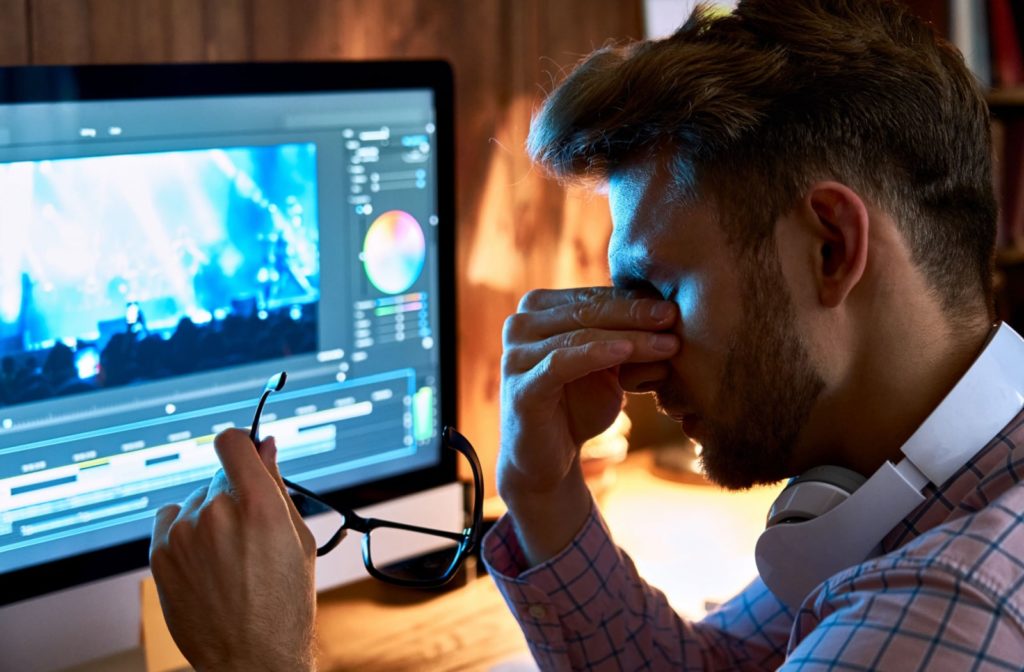The sensation of gritty, sandy discomfort in your eyes can be a sign of dry eye syndrome, a condition in which the eyes do not produce enough tears or the tears evaporate too quickly.
If you’re experiencing dry eyes later in the day and at night, it can stem from a range of causes including reduced blinking, low humidity, medication, or digital eye strain. While dry eye is a common complaint, you don’t have to suffer through the symptoms. A visit to your optometrist can help you find the right treatments to restore comfort to your eyes.
Reasons for Dry Eyes at Night
Dry eyes can develop at any time of day, from when you first wake up, through your workday, on your commute home, or during leisure time. Some of the most common dry eye symptoms include:
- Burning or stinging sensation
- Grittiness
- Sensitivity to light
- Eye fatigue
- Difficulty wearing contact lenses
Identifying the reasons for your dry eye can help you feel more comfortable at night and throughout the day.
Reduced Blinking
Blinking is necessary to keep the eyes lubricated and moisturized. Blinking not only helps to distribute tears across the surface of the eye but also helps to remove any debris or dust that might be present on the surface of the eyes. Reduced blinking when working on clos-up tasks and screens causes tears to evaporate, leading to dry eyes.
Low Humidity
Most people run their air conditioners or heaters at night to stay comfortable; any temperature control device can cause low humidity. Lower humidity levels mean dryer air, which means less moisture to keep your eyes lubricated.
To combat dry air from your fan, furnace, air conditioner, or arid climate, add a humidifier to your sleeping space. It can help support the eye’s moisture barrier and healthy tear evaporation.
Medications
Some medications, such as antihistamines and decongestants, can cause a decrease in tear production, leading to dry eyes. If you take these medications at bedtime, the effects may be more noticeable since your eyes are closed and the tears are not evenly distributed over the surface of your eye.
Talk to your optometrist for tips on keeping your eyes hydrated when taking critical medications.
Digital Eye Strain
In the era of electronic gadgets, digital eye strain is becoming increasingly common. When you spend prolonged periods in front of a screen, your eyes may not blink enough, leading to the evaporation of tears and inadequate distribution of moisture.
Staring at a bright screen also decreases the production of melatonin. This hormone helps regulate sleep, which in turn can disturb sleep patterns, leading to fatigue and eye discomfort related to tiredness.
Dry Eye Treatments
For those who experience chronic dry eye symptoms, relief may come in the form of
- Eye drops
- Punctal plugs
- Serum tears
- Heat masks
Discuss the options with your optometrist to find the ideal solution for your unique case of dry eye.
Medicated Eye Drops
Eye drops designed to increase tears and lubrication are the most common treatment for dry eye symptoms. Medicated eye drops are available over the counter, but prescription strength may be required for chronic dry eye patients.
To determine the best eye drop, it’s essential to consult with an optometrist to evaluate the level of dry eye symptoms and the cause of dry eyes.
Punctal Plugs
Another effective and noninvasive treatment for dry eyes is punctal plugs. These tiny silicone or collagen plugs are placed inside the tear duct or opening on the lower eyelid and prevent tears from draining away too quickly.
Punctal plugs can provide long-lasting relief for moderate to severe dry eye symptoms if your symptoms are caused by dysfunction with your tear ducts.
Serum Tears
For patients with severe dry eye, serum tears may be a viable solution. Serum tears are created by drawing a small amount of your own blood to extract the serum, which resembles tears. This serum is then mixed with saline solution, sterilized, and applied to the eyes as directed by your optometrist.
Though the process may sound strange, the serum tears are unique to each patient, making them a natural and effective solution for severe dry eye.
Heat Masks
Heat masks applied to the eyes are another excellent treatment option for dry eyes. Heat masks help loosen any blockage in the meibomian glands in the upper and lower eyelids. These glands secrete oil, which mixes with tears to lubricate the eye. Heat masks increase the flow of this oil, thus reducing dry eye symptoms.
Environmental Changes
Although dry eye treatments help relieve symptoms, certain environmental factors can contribute to dry eye. You may also relieve symptoms by making changes like:
- Avoiding wind and smoke conditions
- Using a humidifier
- Wearing wraparound sunglasses when you’re outside
- Drinking 8 to 10 glasses of water
Find Long-Term Dry Eye Treatment in Loveland
While the proper dry eye treatment varies based on the severity and cause of the condition, many options are available for those dealing with dry eyes. Trust the optometrists at 2020 Eyecare Ohio to evaluate your condition and recommend the ideal solutions for you.
For a personalized dry eye assessment, schedule an appointment and discover the possible solutions.



